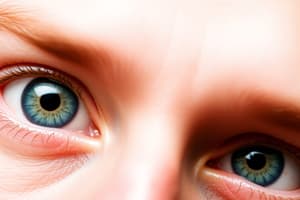Podcast
Questions and Answers
According to Weber's law, if a just noticeable difference (JND) for a 50g weight is 5g, what would be the approximate JND for a 200g weight, assuming the ratio remains constant?
According to Weber's law, if a just noticeable difference (JND) for a 50g weight is 5g, what would be the approximate JND for a 200g weight, assuming the ratio remains constant?
- 5g
- 2.5g
- 10g
- 20g (correct)
A researcher is conducting an experiment on auditory perception. They find that a participant can just distinguish between a 1000 Hz tone and a 1010 Hz tone. Based on this, which of the following changes in frequency would the participant likely be able to distinguish, according to Weber's Law?
A researcher is conducting an experiment on auditory perception. They find that a participant can just distinguish between a 1000 Hz tone and a 1010 Hz tone. Based on this, which of the following changes in frequency would the participant likely be able to distinguish, according to Weber's Law?
- From 500 Hz to 502 Hz
- From 2000 Hz to 2030 Hz (correct)
- From 500 Hz to 505 Hz
- From 2000 Hz to 2010 Hz
A wine taster can distinguish a difference of 1 unit of tannin in a wine with 10 units of tannin. According to Weber's law, how many units of tannin would need to be added to a wine with 50 units of tannin for the taster to notice a difference?
A wine taster can distinguish a difference of 1 unit of tannin in a wine with 10 units of tannin. According to Weber's law, how many units of tannin would need to be added to a wine with 50 units of tannin for the taster to notice a difference?
- 5 units (correct)
- 2 units
- 1 unit
- 10 units
If the JND for a sound at 40 decibels (dB) is 4 dB, which of the following sound levels would most likely be perceived as just noticeably different from a sound at 60 dB, assuming Weber's law holds?
If the JND for a sound at 40 decibels (dB) is 4 dB, which of the following sound levels would most likely be perceived as just noticeably different from a sound at 60 dB, assuming Weber's law holds?
In a taste-testing experiment, a participant can distinguish between a solution with 0.1% salt concentration and a solution with 0.11% salt concentration. According to Weber's law, what concentration of salt would need to be added to a solution that already has a 0.5% salt concentration for the participant to notice a difference?
In a taste-testing experiment, a participant can distinguish between a solution with 0.1% salt concentration and a solution with 0.11% salt concentration. According to Weber's law, what concentration of salt would need to be added to a solution that already has a 0.5% salt concentration for the participant to notice a difference?
Flashcards
Just Noticeable Difference (JND)
Just Noticeable Difference (JND)
The smallest detectable difference between two stimuli.
Difference Threshold
Difference Threshold
Also known as the difference threshold, it's the point at which a change in stimulus is detectable 50% of the time.
JND and Stimulus Intensity
JND and Stimulus Intensity
As the intensity of the original stimulus increases, the difference threshold also increases.
Weber's Law
Weber's Law
Signup and view all the flashcards
Weber's Law: Change Detection
Weber's Law: Change Detection
Signup and view all the flashcards
Study Notes
- The just noticeable difference (JND), or difference threshold, refers to the smallest difference between two stimuli that a person can detect 50% of the time.
- The difference threshold increases as the intensity of the original stimulus increases.
- A 2g difference between 100g and 102g may be detectable, but a 2g difference between 500g and 502g may not be.
Weber's Law
- Weber's law states the ratio of the size of the JND to the original stimulus intensity stays constant.
- The change in a stimulus needed to detect a difference is a constant proportion.
- For instance, if one can detect a difference between 100g and 102g, then the difference between 500g and 510g would also be just detectable.
- If 0.2g of sugar in 20mL of suspension Z is just noticeable 50% of the time, then 0.5g of sugar (0.2g x 2.5) would be the JND in 50mL (20mL x 2.5).
- Adding 0.2g of sugar to 50mL of oral suspension Z would not be detectable based on Weber's law.
Studying That Suits You
Use AI to generate personalized quizzes and flashcards to suit your learning preferences.




